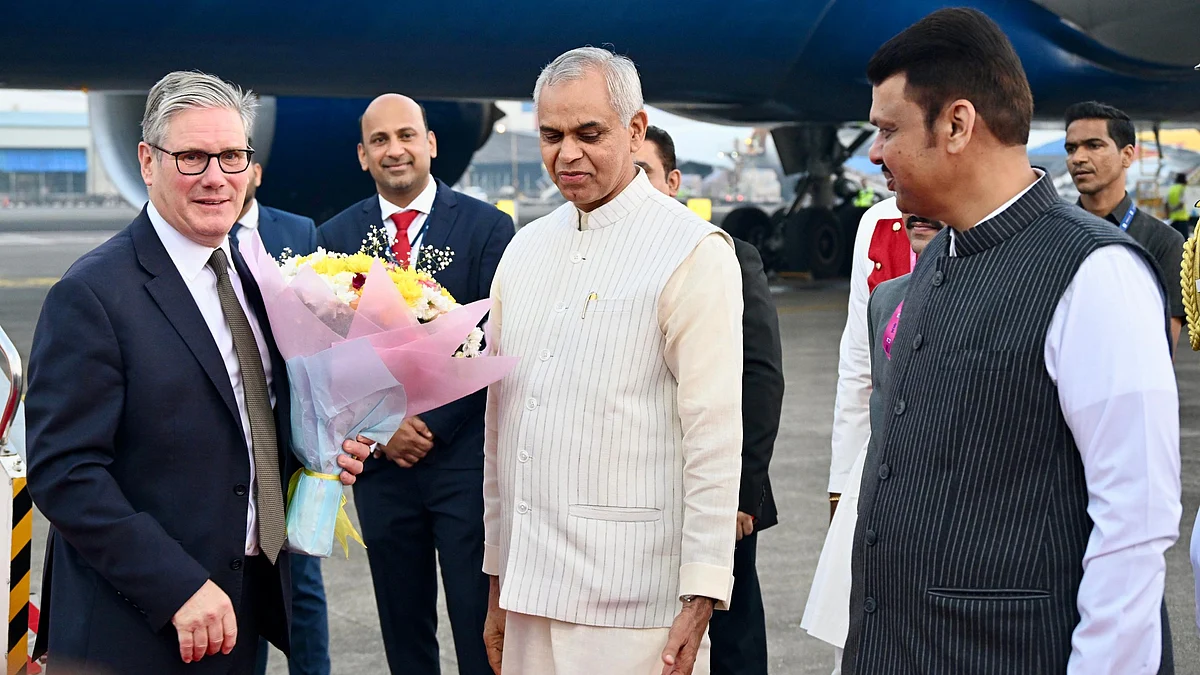Keir Starmer in India: From football and Bollywood sets to talks with PM Modi
The Mumbai visit is a crucial test for the UK PM to prove the trade deal benefits the UK, while India seeks to assert its market and strategic leverage without compromising sovereignty

United Kingdom Prime Minister Keir Starmer arrived in Mumbai on Wednesday, 8 October 2025 for his first official visit to India since assuming office, a trip widely framed as a “two-day trade mission” by No.10 Downing Street.
However, beyond the formalities and photo opportunities, the visit underscores a far more complex and high-stakes agenda, as both nations navigate shifting geopolitical and economic dynamics.
Starmer was greeted at Chhatrapati Shivaji Maharaj International Airport by Maharashtra and Gujarat Governor Acharya Devvrat and Maharashtra Chief Minister Devendra Fadnavis.
He arrived accompanied by a high-level delegation of CEOs and senior executives from British industry, along with representatives from universities and institutions, signalling the UK’s intent to aggressively position its business interests in the Indian market.
This visit follows the signing of the India–UK Comprehensive Economic and Trade Agreement (CETA) during Prime Minister Narendra Modi’s trip to the UK in July 2025, hailed by both sides as a landmark trade deal. CETA is projected to remove tariffs on more than 90 per cent of goods once ratified by the UK Parliament.
While British officials have described the deal as a “launchpad for growth” and a major win for British business, the timing of the visit amid global trade realignments and reassessments of relations with the United States under President Donald Trump makes the stakes considerably higher than a routine trade promotion exercise.
Starmer’s tightly packed itinerary on Wednesday, 8 October included public engagements such as attending a football match at Mumbai’s Cooperage Ground and visiting Yash Raj Studios, alongside meetings with industrial leaders.
Thursday, the official working day, is set to be the true test of the visit, featuring high-level bilateral discussions with Modi at Raj Bhavan, interactions with industry leaders at the CEO Forum at Jio World Centre, and keynote addresses at the Global Fintech Fest in Mumbai.
The latter will spotlight the India–UK Technology Security Initiative, an ambitious programme aimed at deepening collaboration in emerging sectors such as AI, quantum computing, biotechnology, telecoms, and critical minerals.
The rhetoric surrounding the visit emphasises opportunity: Starmer has highlighted India’s projected growth as the third-largest economy by 2028, and Jyoti Vij, Director General of the Federation of Indian Chambers of Commerce and Industry, described the visit as a potential gateway to “advanced manufacturing, green finance, digital innovation, and mobility of skilled professionals.”
Yet, beyond the optimism lies a critical reality, the transformation of trade agreements on paper into tangible business outcomes is rarely straightforward, particularly in a complex and tightly regulated market like India.
The visit also carries clear political undertones. By personally accompanying senior business leaders and ministers, Starmer is signalling domestic accountability: that the trade deal’s success will be measured by jobs and growth delivered at home.
For India, the visit offers a stage to reinforce strategic and economic ties with the UK while subtly positioning itself in a broader web of international partnerships, especially as both countries recalibrate their trade relations with the United States.
Questions remain about the depth of progress achievable during a visit of such brevity. CETA, despite its headline appeal, still requires UK parliamentary ratification and practical implementation in sectors where regulatory, bureaucratic, and market hurdles are significant.
Additionally, while the visit promises high-profile interactions and ceremonial engagements, the concrete mechanisms for translating trade agreements into operational growth, particularly for emerging technologies and critical sectors, remain to be seen.
In essence, while the visit projects an image of partnership and mutual opportunity, it is also a critical litmus test: for Starmer, to demonstrate that the trade deal delivers measurable benefits to the UK; and for India, to assert that it can leverage its market and strategic position without compromising on regulatory sovereignty or geopolitical priorities. In a world of shifting alliances and complex trade landscapes, the stakes of this ostensibly “commercial” visit extend far beyond Mumbai’s glittering conference halls.
The coming days will reveal whether the India–UK Comprehensive Strategic Partnership, in line with the Vision 2035 roadmap, can move from symbolic gestures to substantive outcomes, or whether it risks becoming another high-profile diplomatic exercise with limited practical impact.
With Agency Inputs
Follow us on: Facebook, Twitter, Google News, Instagram
Join our official telegram channel (@nationalherald) and stay updated with the latest headlines
